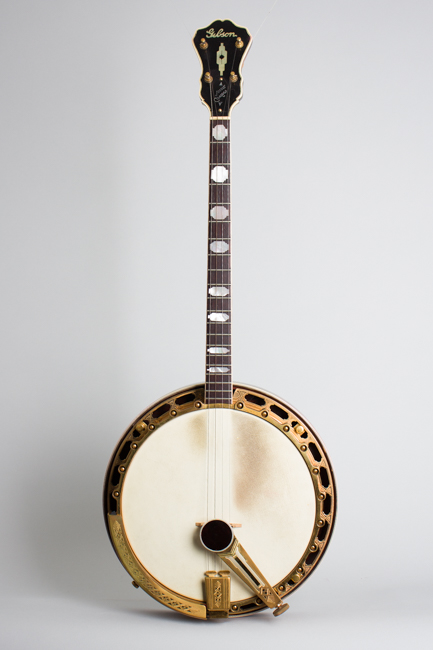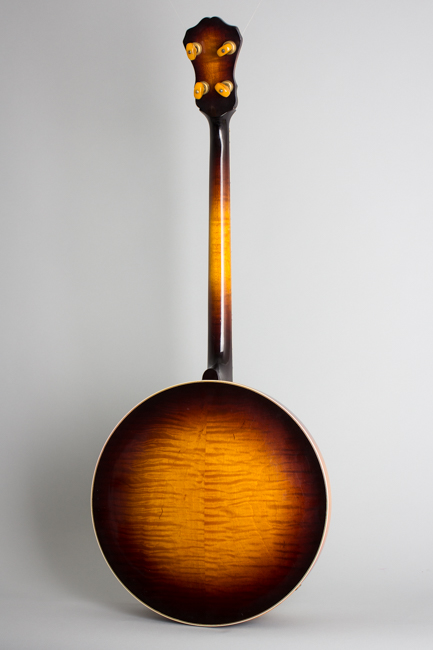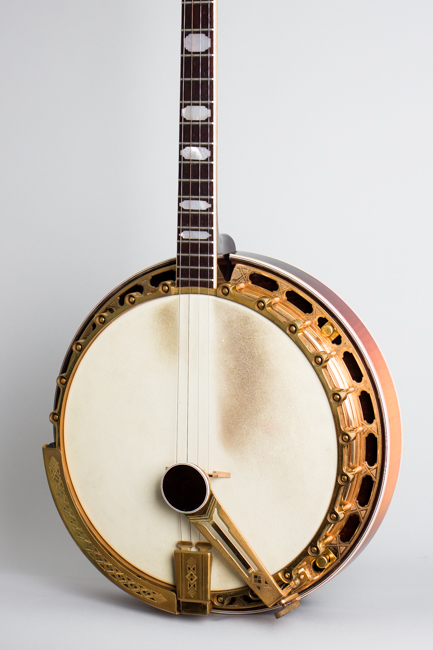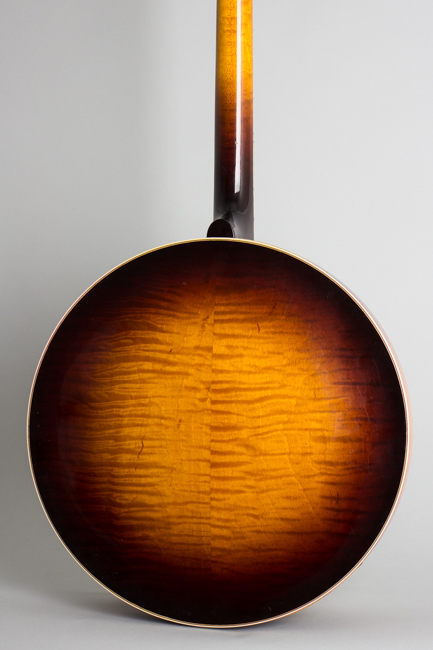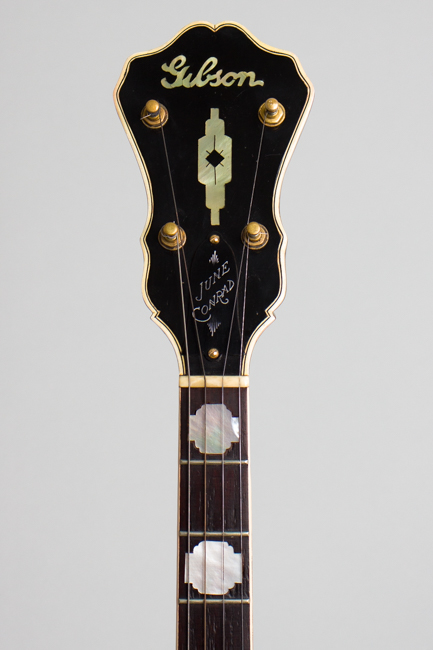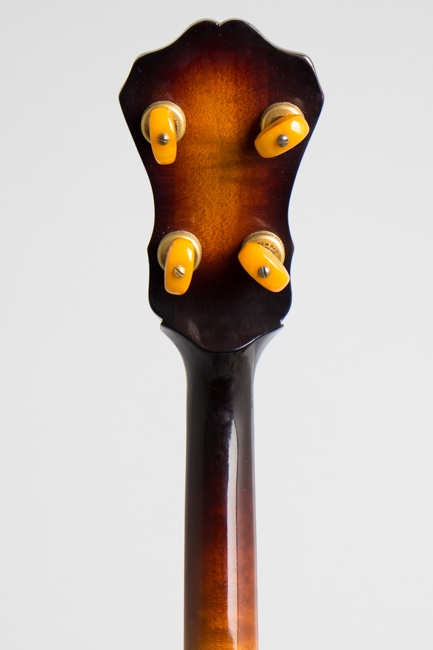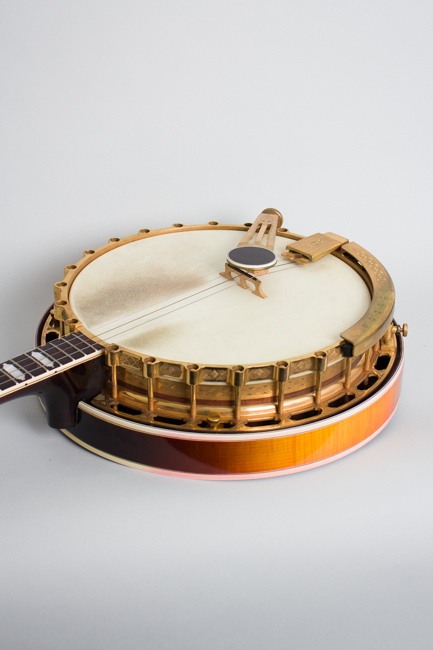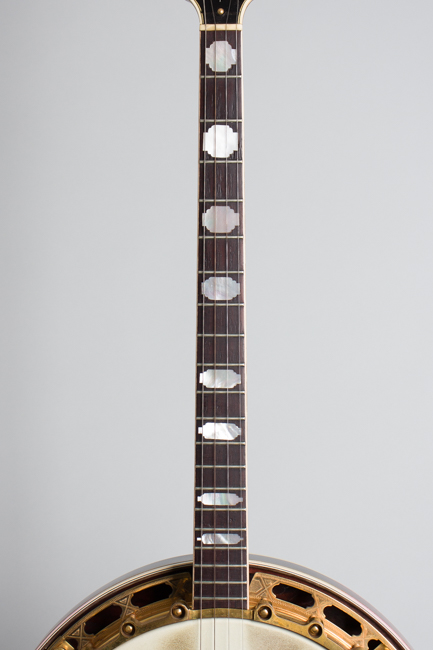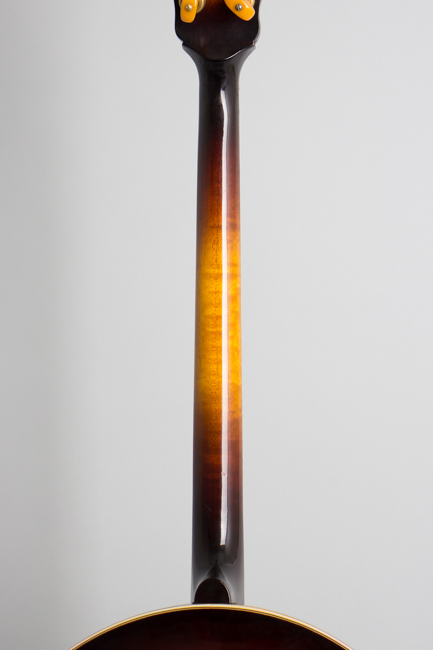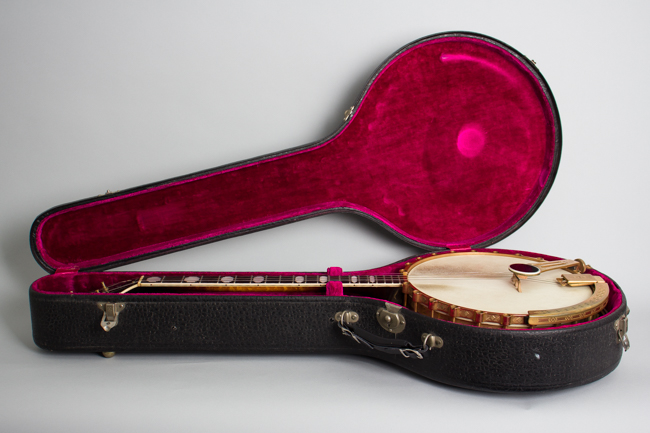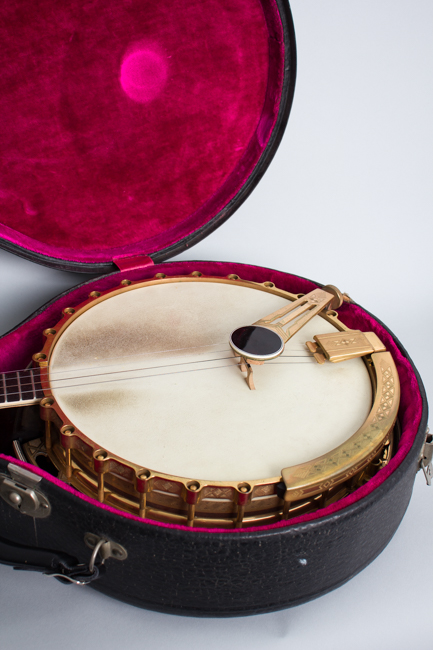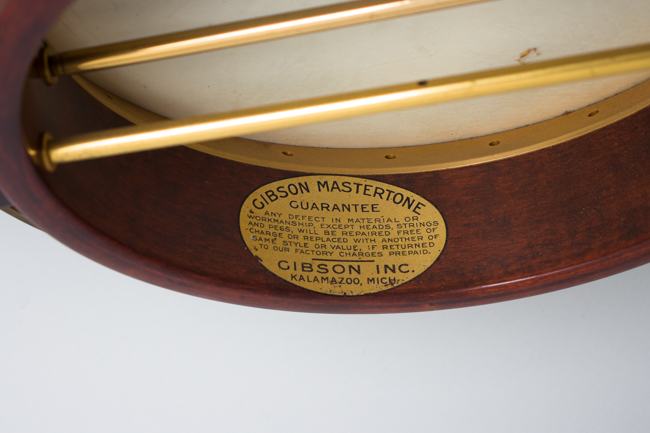Gibson TB-18 Tenor Banjo (1937)
This item has been sold.
Item # 11318
Prices subject to change without notice.
Gibson TB-18 Model Tenor Banjo (1937), made in Kalamazoo, Michigan, serial # 392-2, sunburst lacquer finish, maple rim and resonator, maple neck with rosewood fingerboard, original black hard shell case.
This amazingly original and extremely rare instrument is a Gibson TB-18 tenor banjo made in 1937. This was the top-of-the line, most expensive of the three brand new top-tension banjos which debuted that year. Banjo sales were at a low ebb at the time, many of the builders who had ridden the tenor boom of the 1930s were either gone or going out of business at the time. Gibson was one of the few who were still making professional grade banjos, and the only one to debut a completely new line. This top-line Style 18 was the only gold-plated Mastertone model available between 1937 and the suspension of banjo production during WW II.
The new 1937 Gibson "Professional grade" banjo line was strikingly modern in styling compared to earlier designs. The major structural change was adopting a top tension system for the head, as had been pioneered by Ludwig and Leedy in the 1920s. They were the first Gibson banjos to feature the Bluegrass players' "holy grail" flathead tone ring as universal equipment. They looked and felt very different from earlier Gibsons with bold Art Deco styling, including bolder notched-block inlay in the fingerboard and reshaped angular headstock. The resonator back was elaborately carved from solid flame maple as opposed to a laminated veneer. Another change was a radiused fingerboard, something then common on guitars but unusual on banjos. Gibson called it the "Stream-Flo neck" with "New wide low action frets".
This TB-18 is the most deluxe banjo Gibson offered in 1937; "A New Banjo by Gibson" was highlighted in bold in their 1937-8 Catalog Y which enumerated its features: "Made of beautifully figured curly maple, finished in a hand rubbed Cremona brown with golden sunburst on resonator and neck. Fingerboard made of rosewood with genuine pearl inlays. White-black-white ivoroid binding around top and bottom of resonator, fingerboard, and peghead. Heavily gold plated and engraved metal parts."
The heavily gold-plated metalwork on this banjo is particularly beautiful, with deep and beautifully detailed engraving around contrasting matte and shiny gold accents. The engraved Grover tuners have unique dark amber Catalin buttons specific to this late-'30s era. This TB-18 is fitted with the rare optional wrist-action mute, another brand new feature. This elaborate device added $25 to the cost of the banjo for a total of $225, plus $22.00 for the case. "It will give any banjo player an almost limitless number of effects" Gibson claimed.
With the very limited demand for high-end banjos in the late 1930s, very few TB-18s were sold. Available information indicates 5 shipped in 1937, the first in July '37 along with some salesman's samples of the new banjo line, two more in October and two in November. The factory order number on this banjo (392-2) marks it as the second instrument in what appears to be the second batch, documented by Spann as around mid-1937. While most were tenor models, the Style 18 was available in Plectrum or 5-string configuration by special order.
This banjo has a unique history, a single family instrument since new. It was originally the property of a young lady named June Conrad, who was born in 1924 and played banjo on the radio as a child. The family recalls there were some discussions about her appearing in films that apparently never came to fruition. Nevertheless when she was around 17-18 years old this spectacular banjo was procured for her, complete with her name engraved on the truss rod cover. She played it a bit, then it was apparently put away for decades, only re-surfacing this year. This is simply a fabulous find in a genuine pre-war, flat head Mastertone, one of the most spectacular banjos we have ever seen.
Overall length is 35 in. (88.9 cm.), 11 in. (27.9 cm.) diameter head, and 3 7/8 in. (9.8 cm.) in depth, measured at side of rim. Scale length is 23 in. (584 mm.). Width of nut is 1 1/8 in. (29 mm.).
While showing some relatively minor signs of use, this beautiful banjo has apparently not been played or even much handled since sometime before WWII. There is some very light wear overall, but no alterations and indeed even the strings do not appear to have been changed since FDR was in the White House. While the primary market for this pre-war flathead Mastertone is players intending to convert the instrument to 5-string format it is currently a fine playing and great-sounding tenor.
The only notable issues are the rim of the resonator has minor separations in a couple of spots along the back edge, which are visible but not moving. Some of the binding on the edge of the resonator has taken on a pinkish hue from prolonged contact with the red case lining. There is minor greening in spots to the gold plating but no heavy wear. The one-piece flange is in exceptionally fine condition with no distortion or damage at all. The only piece of hardware not original is the tailpiece bolt; the original is included but the nut slips on the threads (this appears to be a factory mis-fit!) and so a plainer screw has been substituted.
The original frets and fingerboard have some light wear, but nothing that affects playability. The original Rogers head is still intact and very functional, if a bit dirty on some of the surface from play. The original maple bridge and period silked strings are likewise functional if showing their age somewhat!
The original red-line hard shell case is also in exceptionally fine condition, with some minor external wear and a recently replaced handle. Inside the pocket is a plethora of period accessories including the original tension wrench, pre-war Gibson strings, the case key, a truss cover presumably replaced by the factory personalized one, and more, most amazingly the original instruction sheet detailing the care and feeding of the new Mastertone! This is truly a time capsule instrument, an exciting and important piece of Gibson history seeing the light of day for the first time in this century. Overall Excellent Condition.
This amazingly original and extremely rare instrument is a Gibson TB-18 tenor banjo made in 1937. This was the top-of-the line, most expensive of the three brand new top-tension banjos which debuted that year. Banjo sales were at a low ebb at the time, many of the builders who had ridden the tenor boom of the 1930s were either gone or going out of business at the time. Gibson was one of the few who were still making professional grade banjos, and the only one to debut a completely new line. This top-line Style 18 was the only gold-plated Mastertone model available between 1937 and the suspension of banjo production during WW II.
The new 1937 Gibson "Professional grade" banjo line was strikingly modern in styling compared to earlier designs. The major structural change was adopting a top tension system for the head, as had been pioneered by Ludwig and Leedy in the 1920s. They were the first Gibson banjos to feature the Bluegrass players' "holy grail" flathead tone ring as universal equipment. They looked and felt very different from earlier Gibsons with bold Art Deco styling, including bolder notched-block inlay in the fingerboard and reshaped angular headstock. The resonator back was elaborately carved from solid flame maple as opposed to a laminated veneer. Another change was a radiused fingerboard, something then common on guitars but unusual on banjos. Gibson called it the "Stream-Flo neck" with "New wide low action frets".
This TB-18 is the most deluxe banjo Gibson offered in 1937; "A New Banjo by Gibson" was highlighted in bold in their 1937-8 Catalog Y which enumerated its features: "Made of beautifully figured curly maple, finished in a hand rubbed Cremona brown with golden sunburst on resonator and neck. Fingerboard made of rosewood with genuine pearl inlays. White-black-white ivoroid binding around top and bottom of resonator, fingerboard, and peghead. Heavily gold plated and engraved metal parts."
The heavily gold-plated metalwork on this banjo is particularly beautiful, with deep and beautifully detailed engraving around contrasting matte and shiny gold accents. The engraved Grover tuners have unique dark amber Catalin buttons specific to this late-'30s era. This TB-18 is fitted with the rare optional wrist-action mute, another brand new feature. This elaborate device added $25 to the cost of the banjo for a total of $225, plus $22.00 for the case. "It will give any banjo player an almost limitless number of effects" Gibson claimed.
With the very limited demand for high-end banjos in the late 1930s, very few TB-18s were sold. Available information indicates 5 shipped in 1937, the first in July '37 along with some salesman's samples of the new banjo line, two more in October and two in November. The factory order number on this banjo (392-2) marks it as the second instrument in what appears to be the second batch, documented by Spann as around mid-1937. While most were tenor models, the Style 18 was available in Plectrum or 5-string configuration by special order.
This banjo has a unique history, a single family instrument since new. It was originally the property of a young lady named June Conrad, who was born in 1924 and played banjo on the radio as a child. The family recalls there were some discussions about her appearing in films that apparently never came to fruition. Nevertheless when she was around 17-18 years old this spectacular banjo was procured for her, complete with her name engraved on the truss rod cover. She played it a bit, then it was apparently put away for decades, only re-surfacing this year. This is simply a fabulous find in a genuine pre-war, flat head Mastertone, one of the most spectacular banjos we have ever seen.
Overall length is 35 in. (88.9 cm.), 11 in. (27.9 cm.) diameter head, and 3 7/8 in. (9.8 cm.) in depth, measured at side of rim. Scale length is 23 in. (584 mm.). Width of nut is 1 1/8 in. (29 mm.).
While showing some relatively minor signs of use, this beautiful banjo has apparently not been played or even much handled since sometime before WWII. There is some very light wear overall, but no alterations and indeed even the strings do not appear to have been changed since FDR was in the White House. While the primary market for this pre-war flathead Mastertone is players intending to convert the instrument to 5-string format it is currently a fine playing and great-sounding tenor.
The only notable issues are the rim of the resonator has minor separations in a couple of spots along the back edge, which are visible but not moving. Some of the binding on the edge of the resonator has taken on a pinkish hue from prolonged contact with the red case lining. There is minor greening in spots to the gold plating but no heavy wear. The one-piece flange is in exceptionally fine condition with no distortion or damage at all. The only piece of hardware not original is the tailpiece bolt; the original is included but the nut slips on the threads (this appears to be a factory mis-fit!) and so a plainer screw has been substituted.
The original frets and fingerboard have some light wear, but nothing that affects playability. The original Rogers head is still intact and very functional, if a bit dirty on some of the surface from play. The original maple bridge and period silked strings are likewise functional if showing their age somewhat!
The original red-line hard shell case is also in exceptionally fine condition, with some minor external wear and a recently replaced handle. Inside the pocket is a plethora of period accessories including the original tension wrench, pre-war Gibson strings, the case key, a truss cover presumably replaced by the factory personalized one, and more, most amazingly the original instruction sheet detailing the care and feeding of the new Mastertone! This is truly a time capsule instrument, an exciting and important piece of Gibson history seeing the light of day for the first time in this century. Overall Excellent Condition.
